Soil/Landform Unit - Murra Warra West gentle rises
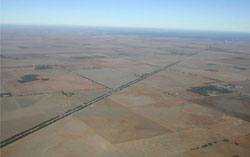 Gently undulating plains and rises north-west of Dimboola along the Borung Highway |
2.5% of CMA region Forming part of an extensive plains complex south-west of Warracknabeal and west of Lake Hindmarsh, this undulating plains unit with gentle rises is part of North West Dunefields and Plains; clay plains with subdued ridges geomorphological unit (5.4). This low extensive alluvial and aeolian unit of Quaternary sediments with occasional rises is bound by Yarriambiack Creek to the east and subdued dunefields, ridges and plains to the north. To the south are the self-mulching, cracking Kalkee plains and to the west is a ridge unit (Kiata) as well as undulating terrain associated with the Wimmera River and the Lowan salt valley. Plains, low rises and playa plains occur with drainage mainly recti-linear where influenced by the underlying NW/SE orientated subdued ridges. Soil types are predominantly grey cracking clay soils (Vertosols) with red sodic texture contrast soils (Sodosols) occurring mainly on rises. Topsoils are light to medium clay, occasionally sandy loams (low rises), often hardsetting and moderately susceptibility to wind erosion. Broadacre dryland cropping is the major enterprise with minor grazing (sheep). Woodland and mallee vegetation communities such as Low Rises Woodland, Ridged Plains Mallee, Plains Woodland and Parilla Mallee dominate remnant vegetation. | 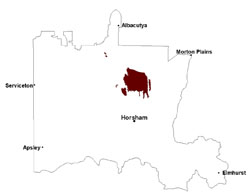 |
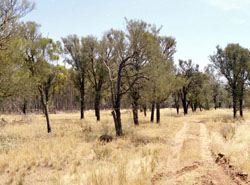 Remnant vegetation on an upper slope of a rise | 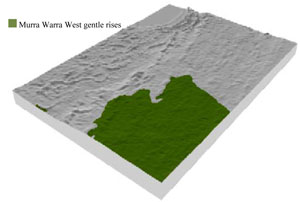 |
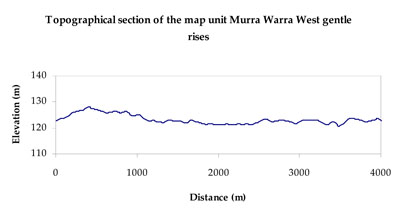 | 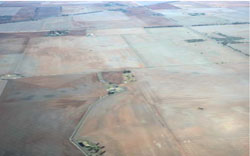 Red plains and rises |
Component | 1 | 2 | 3 |
Proportion of soil-landform unit | 70% | 25% | 5% |
| CLIMATE Rainfall (mm) | Annual: 395 | ||
| Temperature (oC) | Minimum 8, Maximum 22 | ||
| Precipitation less than potential evapotranspiration | September–April | ||
| GEOLOGY Age and lithology | Neogene marine sand and silt (Parilla Sand); Quaternary paludal silt and clay | ||
| Geomorphology | |||
| LANDUSE | Uncleared areas: nature conservation Cleared areas: dryland cropping; sheep and beef cattle grazing | ||
| TOPOGRAPHY Landscape | Moderately undulating plains | ||
| Elevation range (m) | 90–145 | ||
| Local relief (m) | 5 | ||
| Drainage pattern | Dendritic | ||
| Drainage density (km/km2) | 0.6 | ||
| Landform | Undulating plains | ||
| Landform element | Plain | Low rise | Playa |
| Slope and range (%) | 2 (1-5) | 5 (3-10) | 2 (1-8) |
| Slope shape | Straight | Convex | Concave |
| NATIVE VEGETATION Ecological Vegetation Class | Plains Savannah (44.9%), Ridged plains Mallee (32.6%), Low Rises Woodland (8.8%), Other (8.1%) | ||
| SOIL Parent material | Marine sand and silt | Marine sand and silt, aeolian sand | Paludal silt and clay |
| Description (Corangamite Soil Group) | Cracking clay soils (34) | Sodic red texture contrast soils (27) | Cracking clay soils (34) |
| Soil type sites | |||
| Surface texture | Medium clay | Sandy loam | Medium clay |
| Permeability | Moderate to slow | Moderate | Slow to very slow |
| Depth (m) | > 3 | > 1.5 | > 3 |
| LAND CHARACTERISTICS, POTENTIAL AND LIMITATIONS Critical land features, processes, forms | High clay content results in restricted soil drainage, but can be variable due to micro relief (gilgai). Plain may be subject to periodic inundation and waterlogging. Surface soils are friable and only slightly susceptible to wind erosion due to self-mulching and massive nature. Soils may be susceptible at critical moisture contents and have variable resilience to compaction. | Hardsetting surface susceptible to sheet and rill erosion along with wind erosion. Dispersive and deep subsoils susceptible to gully erosion where exposed. Soils are prone to compaction at critical moisture contents. | High clay content results in restricted soil drainage, but can be variable due to micro relief (gilgai). Plain may be subject to periodic inundation and waterlogging. Surface soils are friable and only slightly susceptible to wind erosion due to self-mulching and massive nature. Soils may be susceptible at critical moisture contents and have variable resilience to compaction. |


